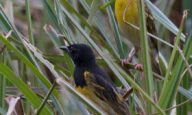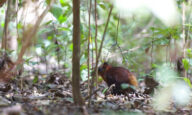The Habitat
Dakatcha Woodland is part of the East African Coastal Forests Global Hotspot, covering nearly 2,000 square kilometres in the rolling hills of Magarini subcounty in Kilifi County. Dakatcha Woodland comprises Mrihi (Brachystegia spiciformis), Mfunda (Cynometrawebberi), mixed forests and thickets. The area’s seasonal wetlands, with sedge and grass, provide nesting sites for the Endangered Clarke’s Weaver (Ploceus golandi).
The forests and thickets trap, store and release rainwater; protect the fragile soil from erosion; and moderate the local climate. The trees and shrubs absorb greenhouse gases such as carbon dioxide, thus slowing climate change. The plants also provide medicines, food and fibre to the local communities.
Ecoregion: Eastern Miombo woodlands (AT0706)

The Endangered Clarke’s Weaver (Ploceus golandi) is found in only two places on Earth: Dakatcha Woodland and Arabuko-Sokoke Forest, on the coast of Kenya. But Clarke’s Weaver ONLY nests in Dakatcha Woodland. Thus without the Dakatcha Woodland, Clarke’s Weaver would become extinct.
Some other threatened birds and animals protected on this land include:
- Endangered Sokoke Pipit (Anthus sokokensis)
- Endangered Sokoke Scops Owl (Otus ireneae)
- Endangered Golden-rumped Sengi (or Elephant-Shrew, Rhynchocyon chrysopygus)
- Near Threatened Fischer’s Turaco (Tauraco fischeri)
- Near Threatened Southern Banded Snake Eagle (Circaetus fasciolatus)
More than eleven rare plant species are also found on this land, including the tree Warburgia stuhlmannii, shrub Pavetta linearifolia, succulent Monadenium invenustum and orchid Eulophia serrata.
Local Partner NGO
Status of registration of the group at the national level
Nonprofit membership society
Governance and management structure of the group
Nature Kenya —The East Africa Natural History Society was established in 1909 to promote the study and conservation of nature. It is Africa’s oldest scientific membership society. The Annual General Meeting (AGM) is the highest governing body and elects the executive committee. The executive committee manages the executive director, who is responsible for 43 full-time (core and project) staff.

Conservation Plans
In the short term, Nature Kenya will own the land through registered trustees. In the long term, Nature Kenya will own the land outright. However, if the government agrees to gazette the land as a national reserve, ownership would revert to the government. Either way, Nature Kenya will remain a permanent trustee/supporter of the land, and the Clarke’s Weaver’s habitat in Dakatcha Woodland will be secured.

Updates
2022:
- Detailed Ecosystem Services Assessment of Dakatcha Woodland was carried out, documenting ecosystem values of Provision Services, Harvested Goods, and Regulation Services of the woodland.
- Dakatcha Woodland Management Plan, informed by the Detailed Ecosystem Services, was carried out in partnership with Kilifi County Government.











